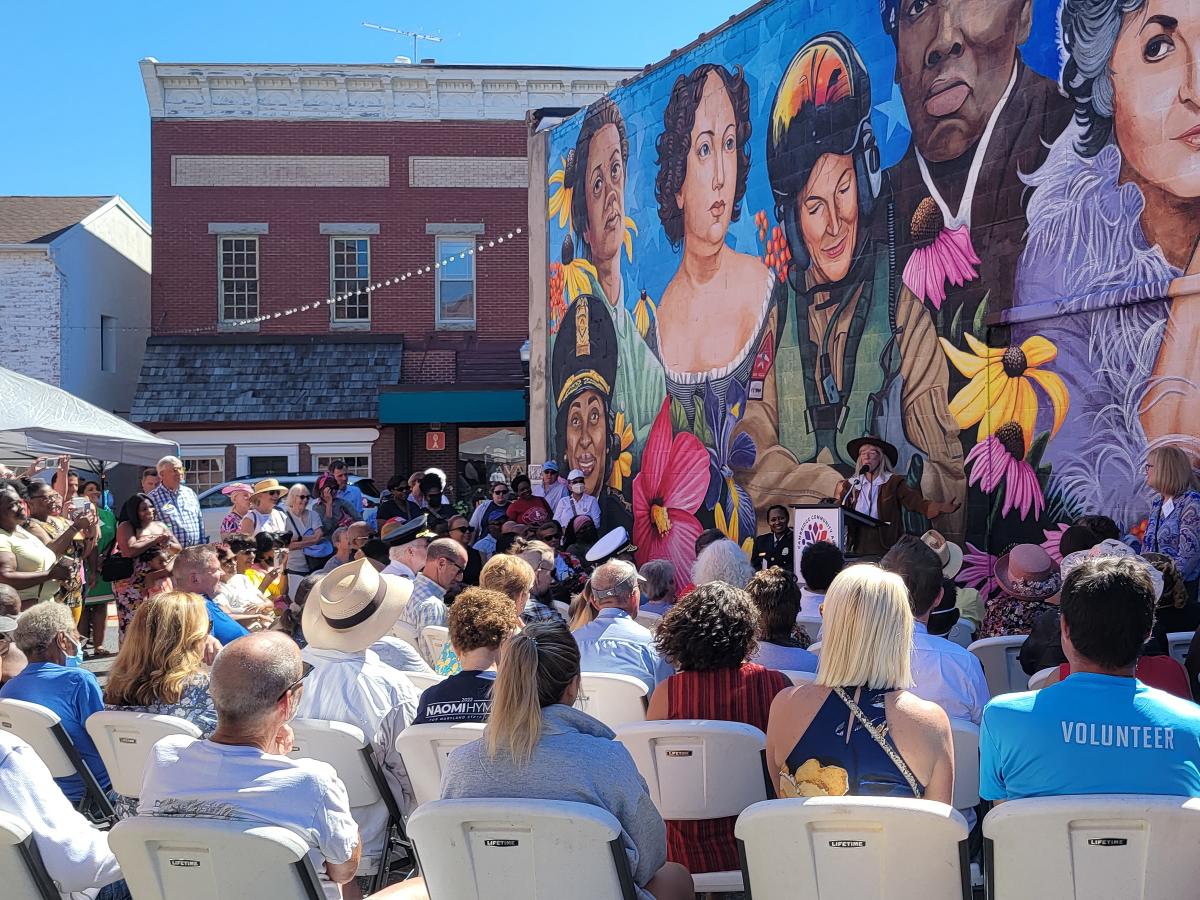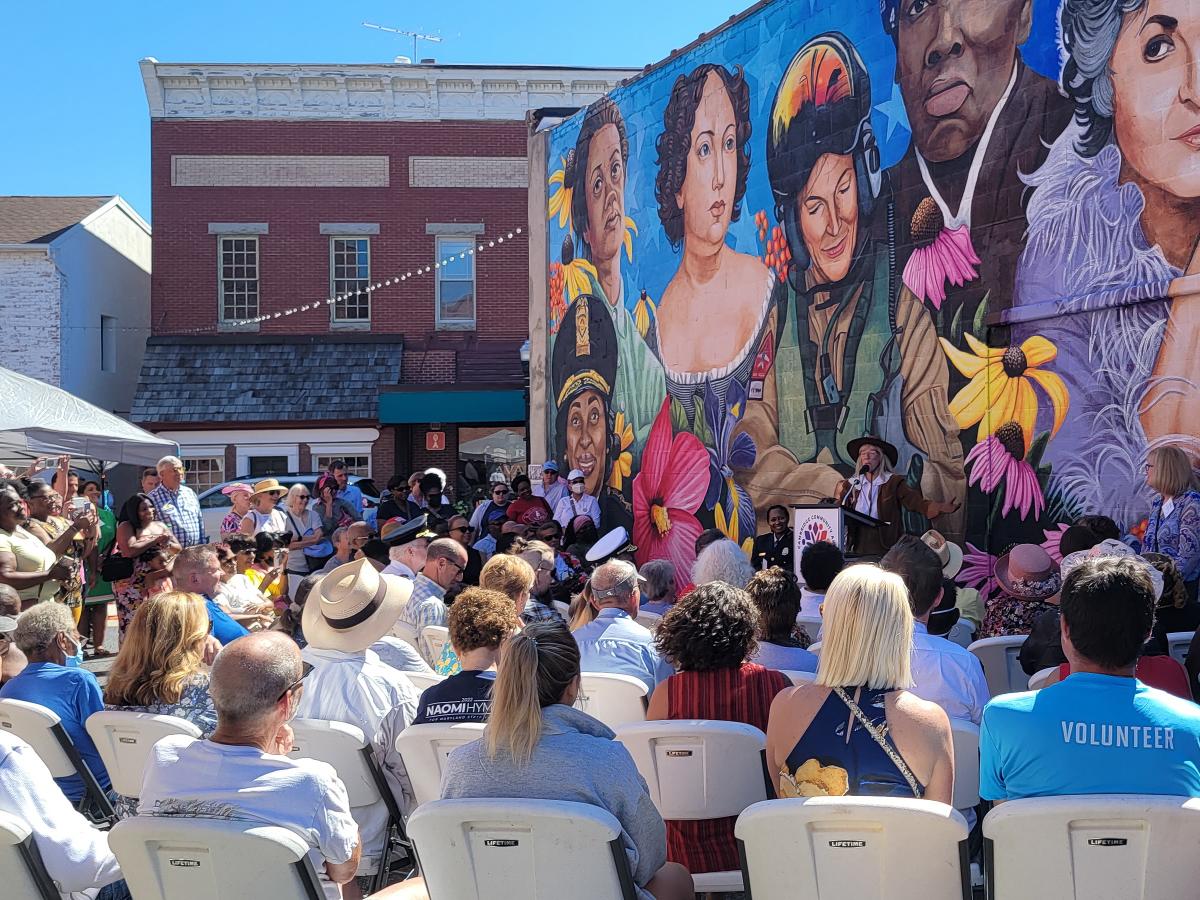The dedication and ribbon cutting of the Dorchester Women’s Mural was held on Saturday, August 13, 2022. The mural, which features 12 Dorchester County women, is located on the sidewalls of 516 and 518 Poplar Street. The Cambridge Community Arts Foundation, Inc. (CCAF) conceived the project, which was funded through grants, local individuals, and community organizations.
The mural was painted by artist Bridget Cimino, whose design was chosen from among the 17 entries received. The portraits took approximately a month to complete, and a day was set aside where people in the community were encouraged to come out and help paint (under the tutelage and watchful eye of Cimino). Once completed, it was time to work on the dedication ceremony and invite the women (or their representatives) who were featured on the walls.
Over 200 people were in attendance on the day of the ceremony. They were there to pay tribute and be inspired by the women chosen both by their contribution to their field and the impact they have made that extends beyond their community. Emceeing the event were Theresa McFadden, President of CCAF, Linda B. Starling, and Lisa Krentel. The three, who are all local artists, and board members of Main Street Gallery and CCAF, were instrumental in launching and managing this mural project. First introduced was Cimino, who expressed her gratitude for the experience and the honor of meeting some of the women whose faces she had spent hours painting.
Yogananda Pittman, former Acting Chief of the U.S. Capitol Police, spoke next, joking, “it doesn’t take much to convince me to come back home. Usually, just an invitation to a bushel of crabs would do it.” Then added: “But when I was chosen to have my face displayed on this mural, with other notable women of this community, I would have walked from Washington DC to be here today. This is beyond anything I could have imagined in my life. Words alone cannot express the gratitude that I’m feeling at this moment.” Pittman noted that her rise in ranks would probably have gone unnoticed were it not for the events of January 6th and her subsequent testimony at the Congressional hearings. She also acknowledged the officers who lost their lives on that day. Pittman expressed gratitude to the community of Cambridge and the influence of teachers and family.
Also recognizing the community was Admiral Sara Joyner, the first female carrier strike fighter squadron leader. She mentioned that in her current work at the Pentagon, she is used to meeting individuals who grew up on the Eastern Shore, calling it a “testament to the type of people who are raised here.” Joyner mentioned the education she received in Cambridge that was instrumental in her being accepted into the U.S. Naval Academy, even though women were not allowed to serve in combat when she first joined. “But ‘no,’ was not something I accepted,” she told the audience. “It became something to overcome.” And so, by 1993, she was allowed to fly jets, although still only in a teaching capacity. When laws finally changed, Joyner did five deployments and almost 100 combat missions. “I’ve had great opportunities,” she said, “and that foundation was formed here. When people told me no, I knew how to get through that, I learned it here.”
The next speaker, Victoria Jackson-Stanley, drew a standing ovation when introduced. As the first woman, first African American, and (three-term) mayor of Cambridge, Jackson-Stanley, expressed the importance of support from family and community members. Referring to others who were memorialized on the wall, she said, “The community of Cambridge has made us all part of history, although I never thought of myself as being history. Someone sitting behind me asked, ‘You’re the mayor? You know you’re history?’ But I didn’t do it for that. I did it because I love Cambridge. I love this community. It has made us all who we are in one way or another.”
Other speakers included Harriet Tubman’s great-great-great grandniece, Tina Wyatt, who reminded the audience that her relative was accused of ‘having stolen herself.’ Mary Handley, Annie Oakley’s impersonator, appeared in costume and gave a brief historical perspective of champion sharpshooter Oakley’s life. Dr. Lida Orem Meredith, the first woman doctor in Dorchester County who was especially noted for serving the underprivileged, was represented by her great-grandson Jay Meredith. Speaking on behalf of Fronie Jones, the matriarch of a legendary 60-year, multi-generational crab picking family at J.M. Clayton’s, was Evangelist Patricia Brown, a granddaughter of Jones. She thanked Cimino for capturing her grandmother’s spirit in her drawing. Civil Rights activist Gloria Richardson was represented by two people who identify themselves as keepers of her flame, Kisha Petticolas, and Dion Banks
Additional women on the mural are Anna Ella Carroll, advisor to President Lincoln, and actress of stage, screen, and television–Bea Arthur. In attendance but choosing not to speak was Donna ‘Wolf Mother’ Abbott, the first woman Chief of the Nause Waiwash tribe.
The last introduction went to Dakota Abbott Flowers, six-time champion muskrat skinner, and former Miss Outdoors. Flowers began by expressing her surprise that her “muskrat skinning skills” would get her on the wall with other women who have helped pave the way for future generations of admirals, chiefs, mayors, and surgeons. She ended with a quote: “What is important in a dress? The woman who is wearing it.”
Following the speeches, Theresa McFadden cut the ribbon. The celebrated women and their families chatted and took pictures with audience members before heading out to a luncheon at the 447 Venue on Race St.
Said McFadden: “We were thrilled with the turnout and the reception the speakers got from the crowd. Their words were powerful and moving, and it was clear how important the mural was to them and their families. The dedication was truly a joyous community event!”
For a time-lapse video of the creation of the mural, click here.





Write a Letter to the Editor on this Article
We encourage readers to offer their point of view on this article by submitting the following form. Editing is sometimes necessary and is done at the discretion of the editorial staff.